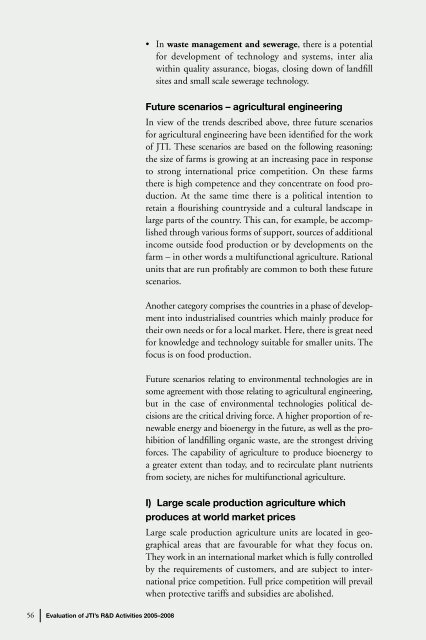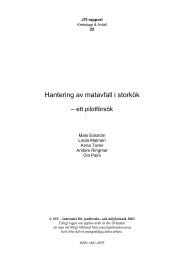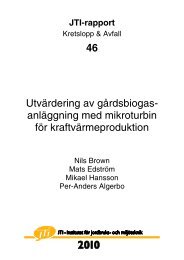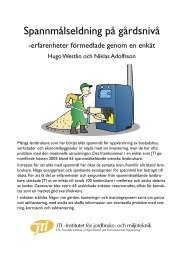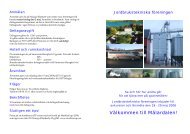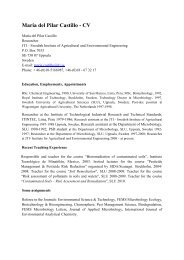Evaluation of JTI's R&D Activities 2005–2008 - Formas
Evaluation of JTI's R&D Activities 2005–2008 - Formas
Evaluation of JTI's R&D Activities 2005–2008 - Formas
You also want an ePaper? Increase the reach of your titles
YUMPU automatically turns print PDFs into web optimized ePapers that Google loves.
• In waste management and sewerage, there is a potential<br />
for development <strong>of</strong> technology and systems, inter alia<br />
within quality assurance, biogas, closing down <strong>of</strong> landfill<br />
sites and small scale sewerage technology.<br />
Future scenarios – agricultural engineering<br />
In view <strong>of</strong> the trends described above, three future scenarios<br />
for agricultural engineering have been identified for the work<br />
<strong>of</strong> JTI. These scenarios are based on the following reason ing:<br />
the size <strong>of</strong> farms is growing at an increasing pace in response<br />
to strong international price competition. On these farms<br />
there is high competence and they concentrate on food production.<br />
At the same time there is a political intention to<br />
retain a flourishing countryside and a cultural landscape in<br />
large parts <strong>of</strong> the country. This can, for example, be accomplished<br />
through various forms <strong>of</strong> support, sources <strong>of</strong> additional<br />
income outside food production or by developments on the<br />
farm – in other words a multifunctional agriculture. Rational<br />
units that are run pr<strong>of</strong>itably are common to both these future<br />
scenarios.<br />
Another category comprises the countries in a phase <strong>of</strong> development<br />
into industrialised countries which mainly produce for<br />
their own needs or for a local market. Here, there is great need<br />
for knowledge and technology suitable for smaller units. The<br />
focus is on food production.<br />
Future scenarios relating to environmental technologies are in<br />
some agreement with those relating to agricultural engineering,<br />
but in the case <strong>of</strong> environmental technologies political de <br />
cisions are the critical driving force. A higher proportion <strong>of</strong> renewable<br />
energy and bioenergy in the future, as well as the prohibition<br />
<strong>of</strong> landfilling organic waste, are the strongest driving<br />
forces. The capability <strong>of</strong> agriculture to produce bioenergy to<br />
a greater extent than today, and to recirculate plant nutrients<br />
from society, are niches for multifunctional agriculture.<br />
I) Large scale production agriculture which<br />
produces at world market prices<br />
Large scale production agriculture units are located in geographical<br />
areas that are favourable for what they focus on.<br />
They work in an international market which is fully controlled<br />
by the requirements <strong>of</strong> customers, and are subject to international<br />
price competition. Full price competition will prevail<br />
when protective tariffs and subsidies are abolished.<br />
56<br />
<strong>Evaluation</strong> <strong>of</strong> JTI’s R&D <strong>Activities</strong> <strong>2005–2008</strong>


